buy almonds in bulk
now browsing by tag
Baking with almonds – classic frangipane

Almonds are not just ideal for gluten-free baking but are also a mainstay of classic patisserie. Here we take a look at the king of the classics; almond frangipane.
What is frangipane?
Frangipane is a classic French pastry cream found in the repertoire of every pastry chef. The main ingredient in frangipane is ground almonds.
Far easier to make than its elegant reputation would suggest, frangipane is simply a mix of almonds, butter, eggs and sugar. Sometimes flour is added to give the mix more stability. It can be mixed with creme patissiere, that other favourite of pastry chefs, to give a soft creamy richness.
How to make frangipane
Frangipane begins with ground almonds. To make your own ground almonds you will need to blanch your almonds. You can put all of the ingredients into a mixer and beat together but the classic way is cream the butter and the sugar first, as you would to make a cake.
Recipe for a classic frangipane almond cream
To fill an 9 inch tart case 250g butter, soft 250g caster sugar 2 egg 2 egg yolk 2 tbsp plain flour 250g ground almonds 1 tsp vanilla paste
-
Cream the butter and sugar together until pale and fluffy. An electric hand mixer is the ideal tool for the job.
-
Beat the eggs and yolks together and beat into the sugar mixture with the vanilla paste.
-
Lightly fold in the ground almonds and the flour.
Make a frangipane tart
The easiest way to make a foolproof frangipane tart is to use tinned fruit. Go for the kind in halves; pears, peaches or apricots.
To line a 9 inch flan tin you will need 300g of shortcrust pastry. The pastry will be cooked along with the almond filling, not blind baked.
Line the tart case and put it the fridge to chill. Pre heat the oven to 190C.
Fill the tart case with the almond filling to just over halfway. Drain the fruit and dry on a paper towel. Press the fruit halves into the filling, creating a circle around the edge. Fill in the gaps at the centre.
Bake in the centre of the oven for about 1 hour, or until the filling is set. It should be golden and well risen. Like cake, a knife inserted into the centre will come out clean.
Once the tart has cooled slightly brush with an apricot glaze made from 2 tablespoons apricot jam brought to the boil with a scant tablespoon of water. Scatter with flaked almonds and cool before slicing into portions. It is best served only just warm.
How to tell if frangipane is cooked
Frangipane is fairly forgiving but like most things it does have a perfect point. It should rise in the oven and form a golden brown crust, with a just set centre. The main cause of undercooked frangipane is baking at too high a heat. The crust will brown too quickly, leaving a soggy centre. Overcooked and it will be dry and granular. As long as it has risen and browned slowly, and you are near the end of the cooking time. you are safe to insert a knife into the filling at the centre. It should come out clean.
What to do with leftover frangipane
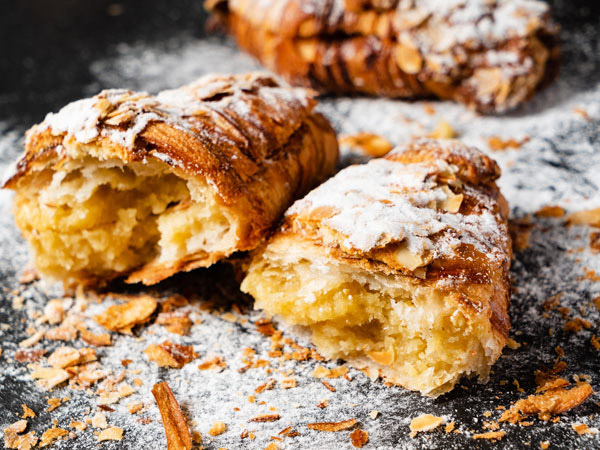
There are many things you can do with leftover frangipane but the most obvious, and utterly delicious, is to make almond croissants. Designed entirely for the purpose of using up leftovers, the almond croissant is made by cutting a (preferably stale) croissant through the centre and spreading with frangipane. You only want a thin layer or the croissant will over brown before the frangipane is cooked. Close it up and bake in the oven until the frangipane is cooked through. Scatter with toasted flaked almonds and a liberal snowstorm of icing sugar. Serve warm, tepid even, not hot.
You can freeze almond pastry cream for several months. Bring it up to room temperature before you use it and give it a good stir as it will separate out a bit.
We hope you have been inspired to try your hand at some classic baking techniques.
All of our Australian almonds are pesticide-free. Did you know it is far more cost effective to buy almonds in bulk?
This article was reproduced on this site only with permission from operafoods.com.au the “Gourmet Online Wholesale Grocer”. See original article:- Baking with Almonds Classic Frangipane.
How to blanch almonds
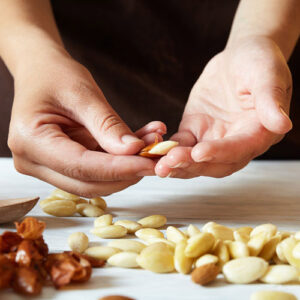
Many almond recipes, especially in baking and patisserie, call for blanched almonds but they can be expensive to buy and are not always of the freshest quality. They also seem to come in really small packets.
So, what are blanched almonds, why are they better than whole raw almonds, and how to blanch almonds yourself at home?
What are blanched almonds?
Technically speaking, blanching is the culinary term for very briefly adding an ingredient to boiling water and then cooling it in cold water (refreshing).
Blanched almonds are almonds that have had their skins removed.
Although it is easy to remove the skin from other varieties of nuts by roasting them in the oven and rubbing them in a cloth or teatowel, almonds are fairly thick skinned so the process of blanching is the tried and tested method of removing their skins.
How to blanch almonds
Blanching almonds is a little fiddly, yet not difficult, and well worth the effort in terms of saving money and ensuring quality.
Bring a pan of water to the boil (size dependant on how many almonds you are blanching) and drop your almonds in. Leave for 1 minute and then drain in a sieve or colander. Return the almonds to the pan and run with cold water. Drain again. You may feel the water is useful for getting the skins off your fingers, which it is. Use a separate bowl for this though or you will find yourself mining for almonds in a pan of skins. Which is really frustrating.
Now that you have wet and wrinkly almonds with loose skins they are much easier to peel.
Pick up an almond between your thumb and forefingers. Gently squeeze so that the almonds pops out of the skin. Put the newly naked almonds on a tray lined with a clean dry cloth, and discard the skins. At this point you can leave them to dry for an hour or so, or place them in a very low oven for an hour to dry out further.
Blanched almonds that have been dried in the oven will grind to a finer flour and have more of a toasted nutty crunch than those that haven’t. Consider what you want to do with your almonds though, as sometimes you want a more creamy delicate flavour and a bit more moisture going on. Think frangipane and macarons.
You can store your blanched almonds for up to a month in an airtight container, in a cool dry place. Ideally though, you should blanch them as required.
What to do with blanched almonds
As previously mentioned, blanched almonds are non-negotiable for classic patisserie and more refined styles of baking. For when you want to whip up a moreish frangipane, or muster up a mass of candy coloured macarons. For these you want to grind raw blanched almonds into ground almonds.
The number one choice for gluten-free baking, almonds are exceptionally versatile and can be used in place of wheat flour very successfully in some recipes. You may want to experiment with making your own almond flour, and playing with different drying times and grinds.
You can blanch almonds before roasting if you wish. Or toss them in a dry frying pan until golden and toasty before decorating cakes and biscuits, or tossing in a salad.
Some people prefer to eat almonds without skins. There is no reason not to blanch almonds before snacking, or even making almond butter. The only time you really would not want to use blanched almonds is when making almond milk. It would simply be a waste of time.
Are blanched almonds healthy?
Almonds are officially a superfood. They provide essential minerals, mono-unsaturated fatty acids, and are one the best sources of antioxidant Vitamin E. The ideal beauty booster, they are of particular benefit to skin, hair and nails.
Almonds with the skin left on are higher in fibre and have more of the nutrient content intact. That said, blanched almonds are still super good for you.
Blanched vs unblanched almonds
Blanched almonds are not necessarily better than unblanched, whole raw almonds. They are just different and are best suited for certain purposes.
Sometimes you want raw and rustic, with more of a wholesome natural feel. Think crumbly speckled almond cookies made from the almond meal that you ground from the leftover pulp after making almond milk.
Other times you may want a substitute for wheat flour. Not only can specks of dark almond skin look less refined but can have a bitter taste and a drying sensation in the mouth. This is because almond skin is a source of tannins. The same compounds that cause the lip puckering sensation in black tea and red wine.
We recommend that you buy unblanched almonds, and then blanch them yourself when need be. Our Australian almonds are pesticide-free. One of Australia’s most important crops, sustainable almonds are vital for our economy and our wildlife.
If you are looking for cost effective ways to use blanched almonds then you could buy almonds in bulk. Or why not do all your bulk shopping at our online store?
How to make the perfect roasted and seasoned almonds
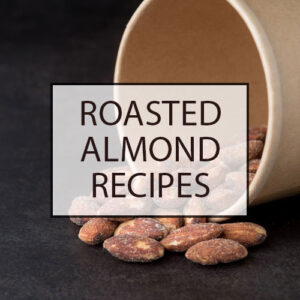
Raw almonds are a lovely thing, with their solid crunch and creamy nutty flavour. In fact, they are pretty much the ideal snack. But lets face it, there are times when you just want something…more. Enter, roasted almonds. All the fun of a bar snack, with better credentials.
Making your own roasted almonds is not only cheaper but also gives you way greater control over the ingredients. Best of all, you know they are fresh.
Roasting almonds transforms the texture into something altogether more crisp and deepens those natural nutty tones.
How to roast almonds
Almonds are roasted in the oven, with or without oil. Using oil makes them more crisp and adds an extra dimension of flavour. You can use any oil you like; olive oil or coconut oil both work well. You will need a good solid roasting sheet and a pre-heated oven. Moving them around occasionally helps them to roast evenly, so have a spatula at the ready too. Note to self…roasted nuts get really hot so don’t go touching them with your bare hands.
How long do you roast almonds?
Nuts take about 15 minutes to roast, but you need to keep a close eye on them as they can go from 0 to 60 super quickly. Anywhere between 8 to 12 minutes is usually optimal. You will need to stir them several times for best results.
What is the best temperature to roast almonds?
Roast your nuts at 350F/180C/Gas 4.
Soaking and roasting almonds
Activated almonds, or soaked almonds, are soaked in salted water and then dried at low temperatures in a dehydrator where they become crisp yet not technically roasted. They can also be soaked and then roasted. Soaking almonds is said to be beneficial to digestion and increase the availability of nutrients in nuts, yet anti-oxidant vitamin E can be lost at the higher temperatures required for roasting. To prevent degradation of these volatile vitamins you would need to go as low as 120F/50C which is nearer to dehydration temperature than roasting. Feel free to experiment with times and temperatures but we would suggest that if nutrition is your main goal then choose soaking followed by dehydration, but when flavour is more important then stick with roasting. Either way you will benefit from the nutritional properties of almonds.
How to season roasted almonds
When it comes to roasting nuts, salt is essential. But all too often it coats unevenly, or just falls off altogether. This is where brining comes in, and it is how the commercial producers get those perfectly salted almonds. The nuts are soaked in a simple brine solution for 20 minutes, drained, and roasted. You don’t need to add any oil.
For 500g almonds (that’s roughly 4 cups), dissolve 2 tbsp sea salt in 1 cup of hot water. Soak the almonds for 20 minutes and then drain off the brine. Roast in a single layer on a baking tray at 180C for about 15 minutes, turning every 5 minutes. If you wish, you can toss the cooling almonds in a tbsp oil and add a scatter more salt.
Almonds also roast well when tossed in ground spices and oil. You can pretty much use any spices you wish, but take care as some have a tendency to burn more easily than others. Paprika for instance.
Roasted almonds recipes
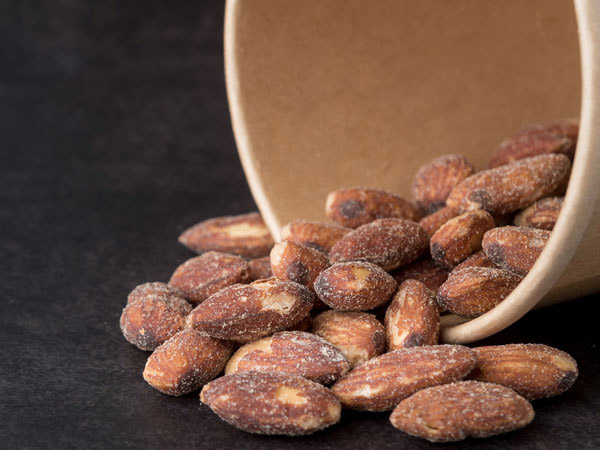
Honey roasted almonds
2 cups raw Australian almonds
1 tbsp oil
2 tbsp honey
1/2 tsp cinnamon
1/2 tsp fine sea salt
- Line a baking tray with parchment paper
- Preheat the oven to 180C/350F/Gas 4
- Toss the almonds in the oil and spread on the tray
- Bake for 5 minutes.
- Tip the now warm almonds into a bowl with the honey, salt and cinnamon.
- Stir to combine.
- Return to the baking tray and bake for a further 10 minutes, stirring occasionally.
- Remove from the oven and cool on the tray.
Coconut roasted almonds
Follow the above recipe but omit the cinnamon and stir in 1/3 cup dessicated coconut. You could add a touch of vanilla paste.
Chilli roasted almonds
2 cups raw Australian almonds
2 tbsp oil
1/2 tsp cayenne pepper
1/2 tsp ground cumin
1/2 tsp ground chipotle
1/2 tsp fine sea salt
- Follow the instructions for the above but bake for 10 minutes at the initial stage
- Toss the nuts in the spices and return to the oven for 5 minutes.
- Leave on the tray to cool.
Cocoa roasted almonds
Add two teaspoons raw cacao powder to the honey in the first recipe.
Savoury roasted almonds
Toss almonds in soy sauce and sesame oil before roasting.
If you are looking for cost effective ways to stay healthy then you could buy almonds in bulk. Or why not do all your bulk shopping at our online store?
How to make almond milk at home
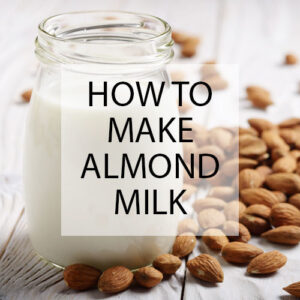
In order to add body and frothing capabilities to commercial almond milk, manufacturers often add various fillers and additives.
Learning how to make almond milk at home gives you total control over the ingredients used. The result will be naturally thick and creamy almond milk.
How is almond milk made in a factory?
Most commercial almond milk is made from Californian almonds. There, the demand is high and the supply unsustainable. A process causing damage to an already fragile ecosystem. Almond milk has been around for centuries but the process came under mass commercialisation just over a decade ago, putting wildlife under threat and endangering the honeybee.
Most industrially produced almond milk contains around 2% almonds. This results in a thin flavourless liquid, which is why so many cartons of almond milk come with a long list of ingredients. Added to provide body and flavour, these extra ingredients may be naturally derived yet are still additives nonetheless.
How to make almond milk at home
To make almond milk you will need fresh, whole, almonds and water. Go for filtered water if that is what you would normally drink at home. You will also need a blender, a sieve, and a clean tea towel or cloth. And a bowl large enough to sit the sieve in.
You may wish to add flavour to your almond milk with a little cinnamon or vanilla. A word to the wise – do try homemade almond milk once before deciding it needs flavouring. Almonds are naturally creamy so the stuff you make is way different to the store bought variety.
The best way to avoid sustainability issues around your almond consumption is to buy local. We wrote all about sustainable Australian almonds and how they are produced, right here.
To make roughly 1 litre of creamy almond milk you will need 1 cup almonds and 4 cups water. You can adjust the ratio of almonds to water depending on how thick you want the result to be. Remember that we said there is about 2% almonds in commercial almond milk? Using 4 cups of water brings that percentage up to 25%, so you can imagine the difference.
Blitz the almonds with the water for about 3 minutes or until the almonds are completely blended. Place the sieve over the bowl, and line with the cloth. Pour in the blitzed liquid and leave to strain until the residue is almost dry. You can give it a helping hand by squeezing the cloth as if you are wringing out a dishtowel. Which, strictly speaking, you are. Pour the resulting almond milk into a container and keep in the fridge for up to 4 days.
Don’t waste the strained nutritious fibre remaining. Sprinkle it on your granola or add it to a Chinese recipe. You can even use almond pulp to make almond meal.
Why not save money and buy almonds in bulk or check out the rest of our wholefoods bulk groceries at our wholesale store
Raw Almonds for Weight Loss and Overall Calorie Control
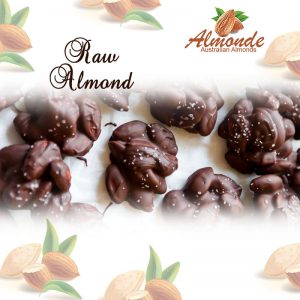
Almonds are a very convenient super food and excellent for weight loss and calorie control. Almonds are packed with lots of anti-oxidants, protein, fiber, vitamin E, manganese, magnesium and more. Pesticide free almonds can be eaten raw or roasted and make wonderful healthy food ingredients whole or ground . Almonds are used to make almond milk, butter, flour, oil, paste and many more healthy products. How about carob coated? or even dipped in organic high cacoa content chocolate.
As almonds are rich in anti oxidants, it helps to reduce oxidative stress, inflammation, aging and severe diseases such as cancer. Raw almonds are loaded with vitamin E, manganese and magnesium which aid to develop cell membranes of individual’s body and protect cells against oxidative damage. It will also lower blood sugar and blood pressure levels.
Almonde is controlled and owned by an Australian family food wholesale business. We gather insecticides free and high grade almonds from growers in the SA of Australia.
Visit our parent company online store at operafoods.com.au to know more details about the product and buy your favorite products now in bulk for overnight delivery.
Premium Natural Almonds for Antioxidants and Minerals
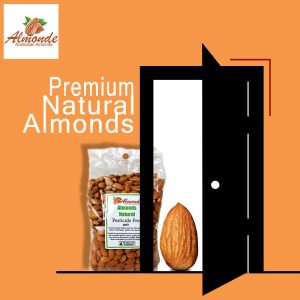
Premium raw natural almonds by Almonde contain antioxidants and vitamin E that is helpful for protecting cells from some damaged conditions which occur with the aid of free radicals in your body. Almonde brand distributes pesticides free and high standard raw pesticide free almonds in Australia. Almonds are rich in argine which aids to develop blood vessels. Almonds are also packed with zinc and iron that helps in the transportation of oxygen to the body of individuals.
Almonds are considered as one of the greatest sources of protein. Almonds nutrition can be helpful in losing weight, lowering blood pressure and cholesterol levels. Almonds make you energetic and it will apease hunger throughout the day. Almonds have monounsaturated and polyunsaturated fats which are good for heart health. They will also develop nerve, muscle function and will make bones strong.
Visit our parent co. Opera Foods web site for more information and buy premium natural almonds now and get online discounts on raw natural Australian almonds.
Almonds are a Healthy Nutritious Superfood
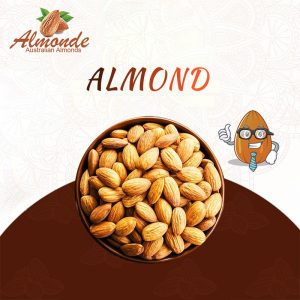
Almonde distributes bulk lots of high quality, raw Australian pesticide free almonds and most importantly, our growers practice natural farming systems for producing healthy almonds in Australia. Almonde is owned and conducted by an Australian family business.
Almonds are rich in fats, protein, fiber, magnesium as well as vitamin E that help to prevent against severe illness.
Almonds can be eaten raw, toasted or can be eaten soaked in milk and many other ways. According to the modern sciences of Australia, almond nuts help to reduce blood sugar and cholesterol levels as they contain large amounts of protein and fiber.
Almonds are regarded as seeds rather than considered as true nuts. Almonds contain powerful toxins that may help to reduce the risk of causing cancer and other severe diseases. It may also aid to lower heart diseases and Alzheimer as almonds possess vitamin E and magnesium.
Buy bulk pesticide free raw natural almonds from Almonde or online direct through our parent company website at Opera Foods.
Almonds are a Healthy and Nutritious Snack
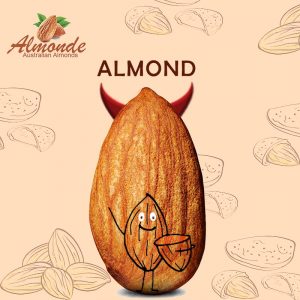
Almonds are considered one of the better convenient superfoods in Australia. Raw Pesticide free Almonds are the products of the Almonde brand. Almonde brand is owned by a family business in Australia. We source raw almonds from the Australian growers that use pesticides free farming practices and grow high-grade almond nuts in Australia.
Almonds are rich in minerals, protein, fiber, and vitamins that aid to prevent diseases of an individual. Almonds can be regarded as seeds; moreover, it can be considered as a drupe rather than considering as true nuts. According to the researchers of Australia, raw bulk almonds are considered as the best regulators of cholesterol level. Raw Almonds are packed with flavonoid activity which is similar to broccoli as well as green tea, therefore, almonds are said to nourish and glow the skin of an individual in the finest way.
Almonds Lower Blood Sugar As Well As Cholesterol Levels
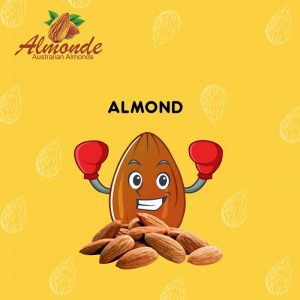
Australian almonds are considered to be the nutritious and healthy snack for the people of Australia. The mission of eating almonds daily is to maximize the growth of our body and to enable a sustainable platform. Almonde has increased its research as well as marketing, into tracking down growers that are using pesticide free growing practices.
The main purpose of growing and cultivating pesticide free raw almonds is to develop communication and sustainability between healthy consumer customers and to focus on the interest of respective Almond growers. Bulk almonds can be available with our parent company Opera Foods and people can purchase almonds from our online store.
Nowadays, Australian pesticide free almonds are becoming popular across different countries of the world. People can make multiple recipes with the help of almonds such as berry breakfast smoothie, almond milk, apple as well as an almond gelato, raspberry, almond and chocolate pudding, beef, broccolini and almond stir fry, apricot, almond, and pomegranate rice pilaf and many more.
Almonds are rich in fats, fiber, protein, vitamin E and magnesium. Almonds help to lower blood sugar, cholesterol levels, blood pressure and many more.
The Right Way to Eat Almonds and Reap All Its Benefits
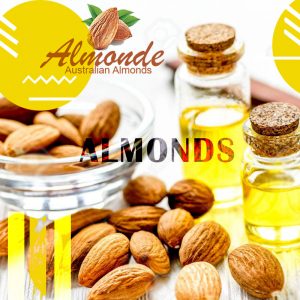
Almonds are a high protein and nutritious nut but eating it the wrong way can cause you to miss some of the nutrients. Hence it might sound illogical but we should be more deliberate while eating almonds on a daily basis. Almonds are a good source of Vitamin-E, omega-3, omega-6 fatty acids and fibers.
Plants find a way to protect their seeds and ensure their progeny survive. So if an animal eats the nut, it can pass through the digestive system unharmed and possibly have a chance to sprout and grow a whole new plant. For humans, this means we can digest nuts better and fully absorb the minerals from them by soaking them.
When these nuts and seeds are prepared by soaking or sprouting or fermenting, most of the protective compounds break down or are leached out, making nuts better to digest.
Through soaking, you trick the nut into thinking it’s time to germinate. Phytate begins to break down, releasing the minerals it was holding onto to fuel the enzymes that the seed requires to grow into a new plant.
So, the best way of eating bulk almonds is to soak or sprout them. Soaked almonds help in removing the inhibitor from them this will help the enzymes to do its job. Almonds are extremely high concentrated food hence you can get better results by soaking or combine it with other fermented foods. You can combine a handful of almonds into a green leafy salad.
Healthy Raw almonds are high in nutrition and are easy to be carried. Order your pack of high grade Australian organic almonds directly from our online store.

 D5 Creation
D5 Creation